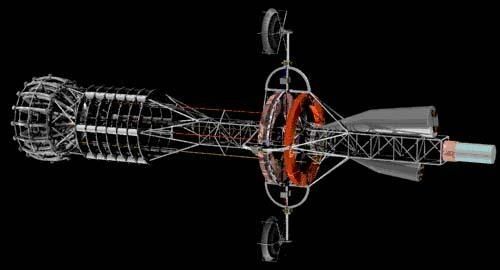
Home - Search - Browse - Alphabetic Index: 0- 1- 2- 3- 4- 5- 6- 7- 8- 9
A- B- C- D- E- F- G- H- I- J- K- L- M- N- O- P- Q- R- S- T- U- V- W- X- Y- Z
ICAN

ICAN Antimatter
ICAN Antimatter Spacecraft
Credit: NASA
Production and trapping of small numbers of antiprotons for space applications were required for the ICAN anti-matter spacecraft concept. The antiprotons would be used in antiproton-catalyzed microfission/fusion (ACMF) micro-explosions as a source of propulsive power. In the ICAN-II concept, a sector of a spherical silicon carbide (SiC) shell of 4 m radius was used to intercept radiation from the explosions. This radiation heated the inner surface of the shell, and the resultant expanding plasma produced thrust.
The ICAN engine would have a nominal thrust of 180 kN, and a specific impulse of 13,500 seconds at a 1 Hz firing rate. To achieve the delta V of 100 km/sec, 362 metric tons of propellant would be required for a 345 metric ton ICAN II dry mass. The spacecraft would be accelerated to 25 km/sec in 3 day at this thrust. For the 800 g of ejected mass required for the mission, about 30 ng of antiprotons would be required. Hence, ICAN-II could be fueled with one year's production of antiprotons at Fermilab, estimated in 1999 to be approximately 140 ng by the year 2000.
Radiation damage to the ICAN-II vehicle could result from neutrons, which posed a threat to the stored targets, antiprotons, and the crew of the vehicle. In order to prevent this, 1.2 meters of lithium hydride shielding (Power Shield) was required. In addition, 2.2 meters of shielding (Crew Shield) was needed to limit crew exposure to ~ 30 rem over the duration of a mission. Finally, part of the intense blast of neutrons from the pellet ignition was absorbed by the Power Shield to drive a 10 MW electric generator, which provided power for the ion drivers and other systems on the spacecraft. A liquid droplet radiator was designed for expelling the excess 60 MW of heat from the Power Shield into space.
Estimates of component masses for a 120 day, delta V = 100 km/s Mars mission were as follows:
- Ion Driver: 100 metric tons
- Engine Structure: 27 metric tons
- Spacecraft Structure: 30 metric tons
- Antiproton Traps: 5 metric tons
- Neutron Shielding: 45 metric tons
- Power Processing: 58 metric tons
- Payload on ICAN: 20 metric tons
- Mars Lander/Surface Payload: 53 metric tons
- Mars Mission Ascent Vehicle: 9 metric tons
Mass of Silicon Carbide Thrust Shell: 362 metric tons
Total Mass of ICAN: 707 metric tons
Family: Space Tugs. Country: USA.
Back to top of page
Home - Search - Browse - Alphabetic Index: 0- 1- 2- 3- 4- 5- 6- 7- 8- 9
A- B- C- D- E- F- G- H- I- J- K- L- M- N- O- P- Q- R- S- T- U- V- W- X- Y- Z
© 1997-2019 Mark Wade - Contact
© / Conditions for Use